Some Suggestions for Growing Roses in Containers

‘Abraham Darby’ seen above. Many of David Austin’s roses are small enough to grow happily in a container if given winter protection in cold-climate areas.
I’ve been getting asked a lot recently for tips on growing roses in containers and to save time decided it’s best to break my own rule about giving specific advice and talk about my method in an official post.
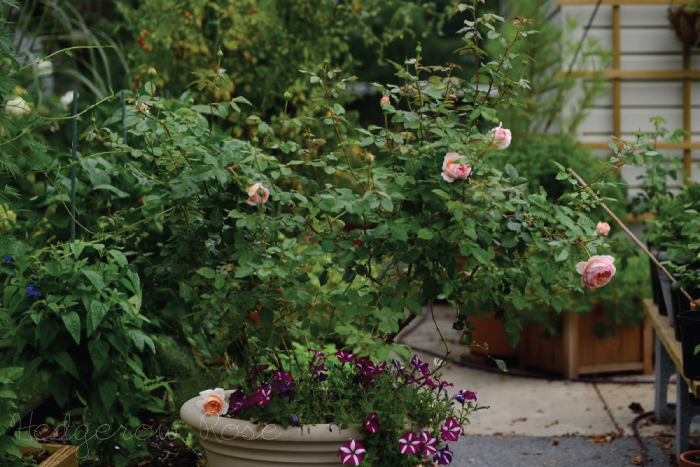
3 important factors to keep in mind:
1.) A container rose is completely dependent on you to provide all of it’s water and nutrients, and it will need a lot during the growing season.
2.) Are you able to provide winter protection if necessary?
3.) All roses require basic regular maintenance, some more so than others.
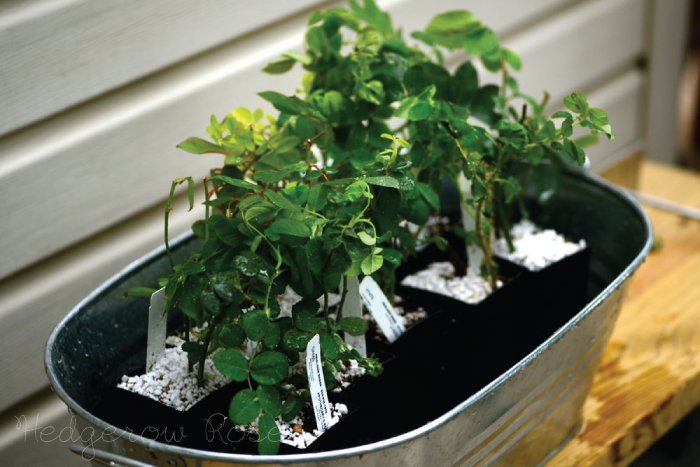
The majority of the roses I purchase are rooted cuttings, or “bands” that are still in their first year of growth. This is a more affordable way to build up a rose collection, not to mention there is an bigger variety to choose from. It takes about 1-2 years before they begin blooming. But once they take off, look out!
And now some things to ask yourself:
1.) What kinds of roses do you like? The long-stemmed florist variety with blossoms tall and pointed like urns?
2.) The lush, romantic roses that have strong scents and full blossoms?
3.) An easy-care, no fuss, no muss rose?
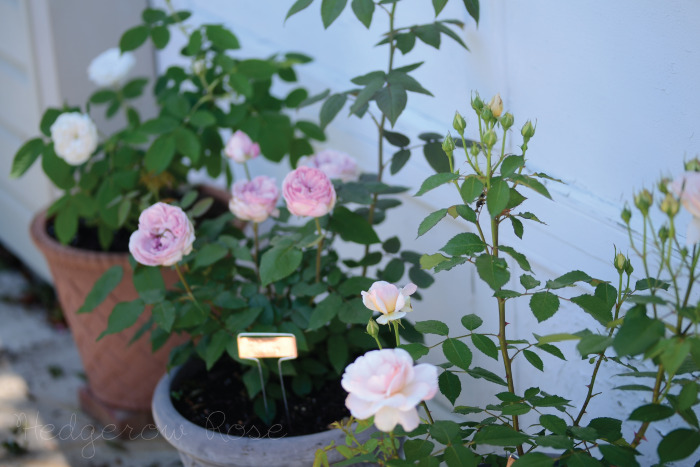
From left – right: ‘Mme Hardy’, ‘Mme Ernest Calvat’ and ‘Grüss an Aachen’ planted in 2-3 gallon containers.
For me, I grow roses in containers because I have to. When my husband finishes his time at PSU, we may stay or we may move and that uncertainty has determined that I want my collection to be portable if necessary. Also, it allows me the time to nurture my rooted cuttings (or “banded” roses–see above), since it generally takes them a few years before they really take off. However, I’ve discovered that having a rose garden in containers has been an unexpected joy. You can underplant them with cascading annuals, move them around to showcase certain ones in bloom, and as the blooms are raised up, it makes them easier to enjoy. I currently have about 60 or so in a container of some kind but you don’t have to do that, of course, because even I can recognize that that’s just crazy.

A view of the container garden. Behind the bench are some of those roses I mentioned earlier which were transplanted into 10 gallon* nursery containers. The middle rose is ‘Mme Ernest Calvat’ which reached heights of 5 feet or so last summer and needs support for her long, arching canes. Black plastic nursery pots are not the most attractive thing in the world, but they are affordable and can be disguised with trailing plants.
Some suggestions for getting started:
1.) Find a large (at least 5 gallon) container with adequate drainage holes. In my experience, the number one reason roses fail to thrive in a container is inadequate drainage. In most cases, I add additional drainage holes to any container I purchase–better too much than too little.
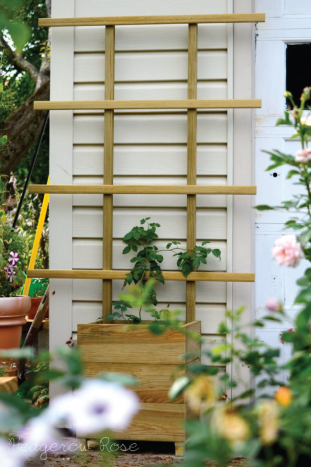
My husband built this container with attached trellis for ‘Souvenir de la Malmaison’ to have a happy home. Now if only I can convince him to make about 60 more of these.
2.) Use a good quality, organic potting mix or blend your own as I like to do. I start with regular potting soil (without the slow-release fertilizer) and mix it with a generous amount of compost. The reason I do not use time-released chemical fertilizers in my container mix is because it inhibits the growth of Mycorrhizal Fungi which helps a rose fight off disease as well as it’s ability to intake water and nutrients. Chemical fertilizers are also harmful to young roses just developing their root systems.
3.) You will need to water your container plants more often. It’s best to water your roses in the morning so the leaves have time to dry off. If you can use rain water, that’s even better. About once/week, during the growing season, I water my roses with compost tea. You can make your own if you have a compost bin, but my roses especially like the tea I purchase from Haven.
4.) Be vigilant with inspecting for pests and diseases (this is another post I think I’d better write). Deadhead as necessary. Here are some tips for when to stop deadheading and fertilizing.
 Underplanting container roses with trailing annuals is a great way to keep the show going even when the roses are in a period of rest. It also shades the roots from extreme temperatures and disguises less-than-ideal containers. These flowers are Calibrachoa which also attract pollinating insects.
Underplanting container roses with trailing annuals is a great way to keep the show going even when the roses are in a period of rest. It also shades the roots from extreme temperatures and disguises less-than-ideal containers. These flowers are Calibrachoa which also attract pollinating insects.
 With the larger of the containers pushed to the back, and the smaller raised up on makeshift benches, I’ve found a way to store the more tender of our container-planted roses in our garage for winter.
With the larger of the containers pushed to the back, and the smaller raised up on makeshift benches, I’ve found a way to store the more tender of our container-planted roses in our garage for winter.
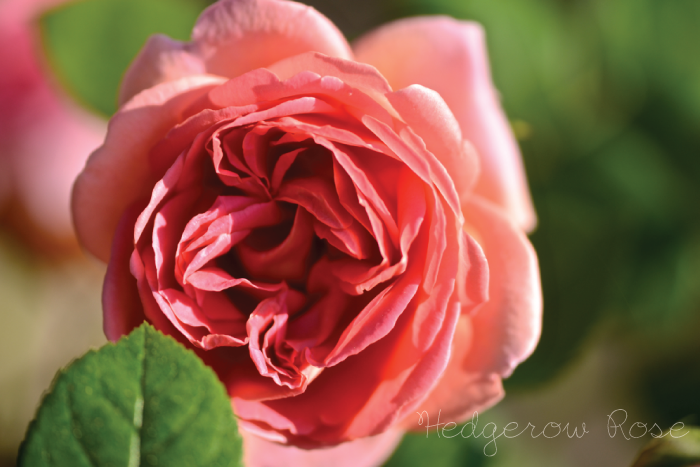
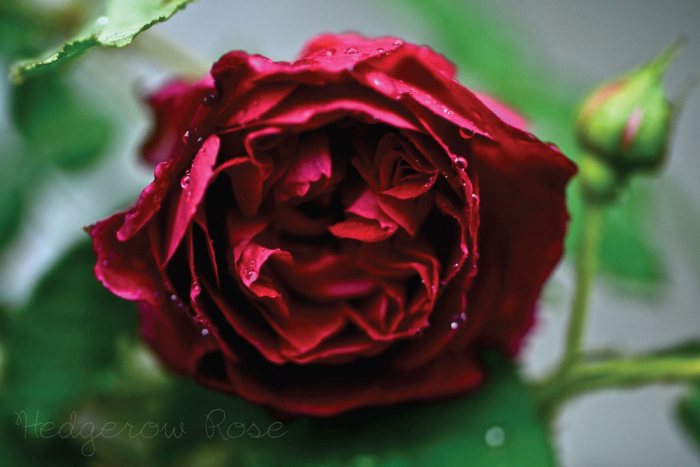

What started out as a necessity, the rose container garden is now my favorite place!
Roses that are kept in containers can live happily there for several years if their needs are provided for. Top off regularly with compost and move them to a protected location in the winter if you live in a cold climate. After a few years, you may need to remove the rose from the container and do some root pruning, or move to the garden into a permanent location.





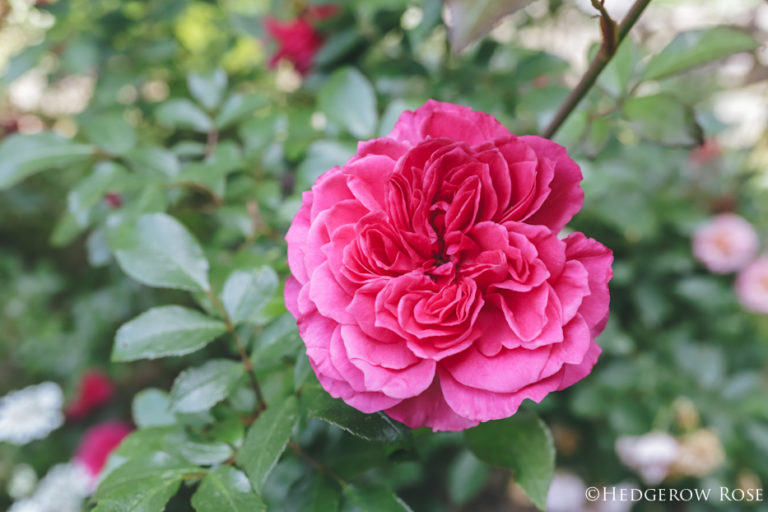
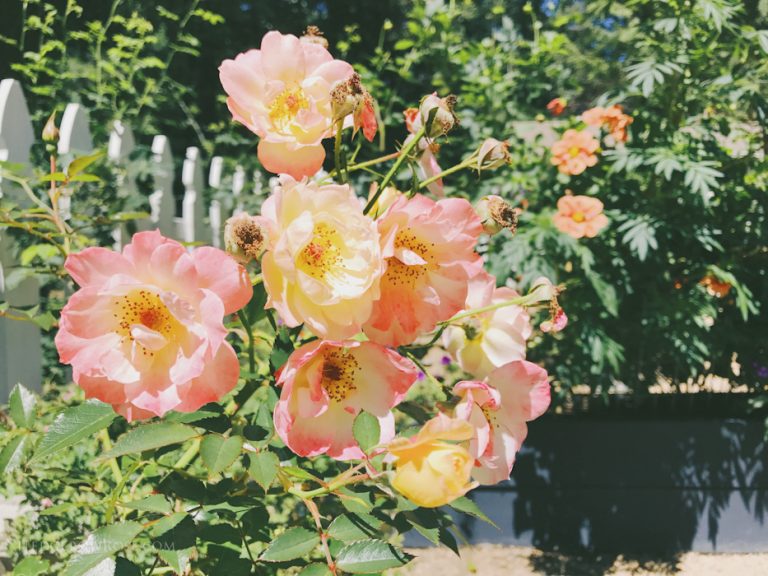
Thanks SO much Lara! Bookmarking for a little closer to spring. I would love to add one or two roses to get my collection started this year. This will be so helpful!
Oh yay! I’m so glad I was able to help!
Some great advice here! Thanks for this post on container plantings.
Thank you Chris!
Thanks for the post and the lovely pics! If I might ask a followup question or two – I’ve been thinking of buying some band-sized roses, but I’m wondering about growing them to full size. Does starting them out in one gallon containers sound about right, or is that a bit big? Any advice about how many times I might expect to repot them before they end up in that 10/15 gallon container? It’s especially nice to see the larger roses growing with other flowers in the same container, I was hoping that was possible despite the advice I was seeing saying it couldn’t or shouldn’t be done – looking at your results, clearly, you are doing it just fine!
Hi Roberta! Yes, I transplant my banded roses to a 1 gallon size container initially. (If you purchase them from Rogue, Vintage Gardens or Heirloom they will arrive with very specific, helpful planting instructions.) Some of my roses grew incredibly fast and needed to be transplanted again in the same season to a 10 gallon container, such as ‘Arcata Pink Globe’ which you can see HERE but others, such as ‘Golden Moss’ are still chugging along in their one-gallon pot so I guess it depends on the rose. The bareroot roses I purchased from David Austin and Jackson and Perkins were much larger, of course, and so were immediately planted in the largest containers I could find and I underplanted them with Calibrachoa, ‘Wave’ Petunias, Lobelia, and Bidens which did a nice job covering up the base of the container and provided color season long. About the ‘Wave’ petunias, I won’t do those again because they actually engulfed the rose they were planted with. The Calibracho and the Bidens were my favorite, especially the combinations of purple and yellow. I’ve never seen that underplanting the larger containers (I didn’t do this with the 1 and 3 gallon pots) with annuals couldn’t be done and I’m glad I didn’t or I might never have tried it. It worked for me and I hope it works for you! Good luck!
Thanks, Lara! I probably should have known that I would get instructions with the plants, but nope, didn’t occur to me. I’m not sure how many bands I will be getting, because the day after I posted this I found a nursery just north of here that carries 600 (600!!!) different roses, but even so there were a couple they didn’t have, so I guess I will still be ordering a few. As for the annuals, thanks for the tip on the hazards of Wave petunias! Several sites I found while looking for info on roses in containers were adamant that one should never plant anything in the container except the rose, but gave no reason for it. It seemed like one of those many gardening myths out there, so I was especially glad to see that you were doing it so successfully with those lovely calibrachoa. Who needs/wants/likes giant swaths of bare dirt? Bleah….
Wow, a nursery that carries that many roses would be really dangerous for me, haha… You’re going to have so much fun this spring! Let me know how everything works out!
How often did you water them during winter?
Hi Jessica, I’m so glad you asked that question because going into last winter, I was wondering the same thing myself. Basically, I kept a good eye on them and did not allow them to dry out completely. We had a relatively warm winter and I ended up giving them each a little bit of water–just enough–about 2-3 times. I think it will probably depend on the situation and the type of winter you have.
Thats what I was thinking just making sure not to let them dry out.
where do you get your pots… I have looked and I found one site that has them they are made in usa but they only have a few to choose from with the bigger gallons..
http://plasticflowerpots.net/
I am talking about the blue or black ones sorry didn’t clarify
I buy them here: http://homeharvest.com/containergardenpotsplastic.htm Not sure if they are the best or the least expensive out there, but it’s worked well for me so far.
Question but how do you prune the roots..
I haven’t yet felt the need to prune the roots of my container roses but this forum has some discussion on that topic that may help you. Good luck!
Well when do you feel the need to repot in a bigger pot? Are the roots visible at the bottom? I am planning on getting much bigger pots anyways but just wondering
I suppose you could check for roots but you would probably notice the rose not doing as well before that even happens. I’ll tell you what, though, I recently planted Mme. Calvat in the garden because it was so big I thought surely it needs to get out of it’s (10 gallon) container. But when we took it out, the root ball didn’t even extend to the bottom of the pot–there was a good 6 inches of soil below the roots. I’m finding one of the biggest things that might lend to a rose’s decline in a container is actually poor drainage. But I’m still learning here, too. So take everything I say with a grain of salt!
Hehe will do